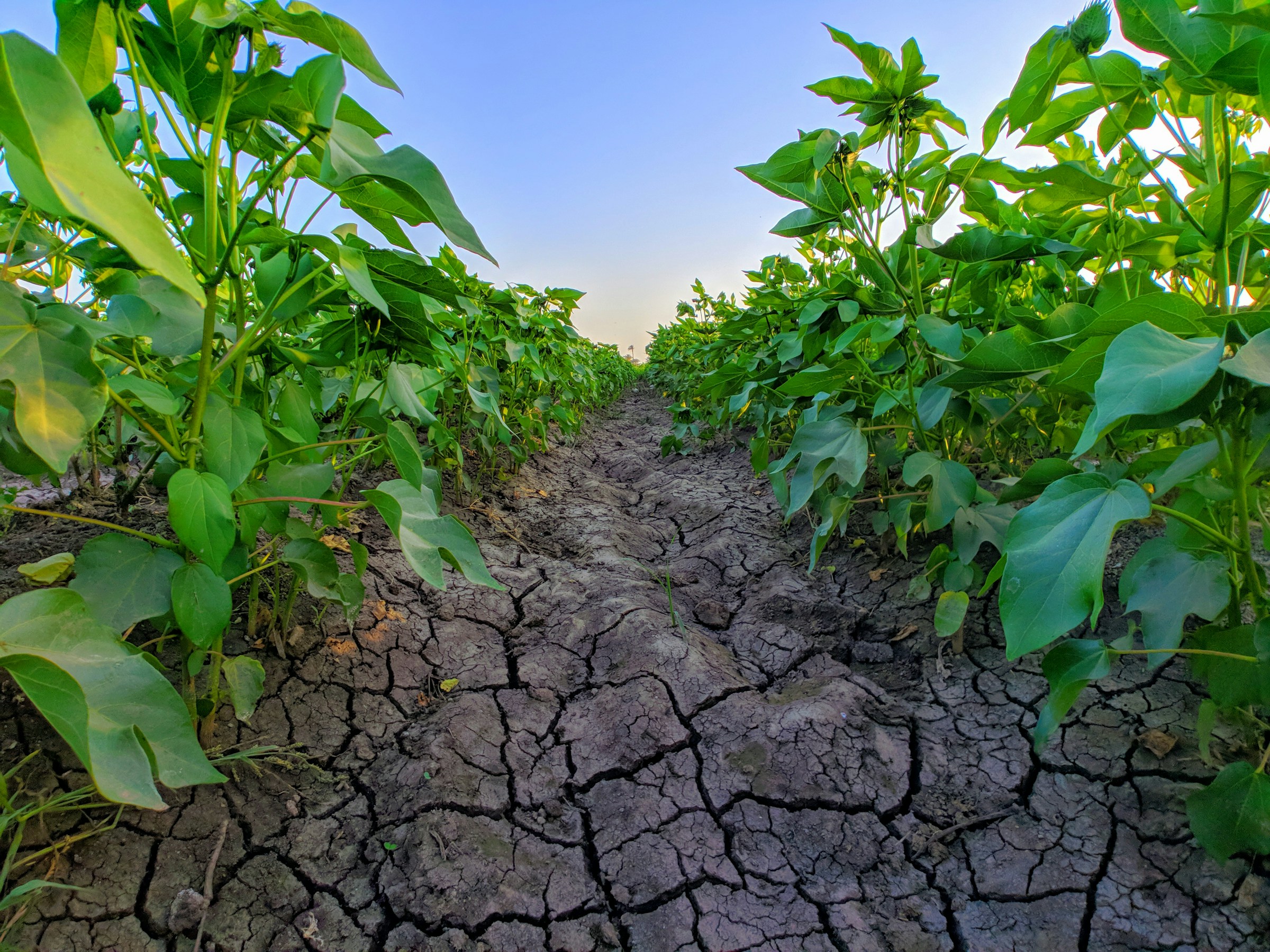

Problems
Our solution
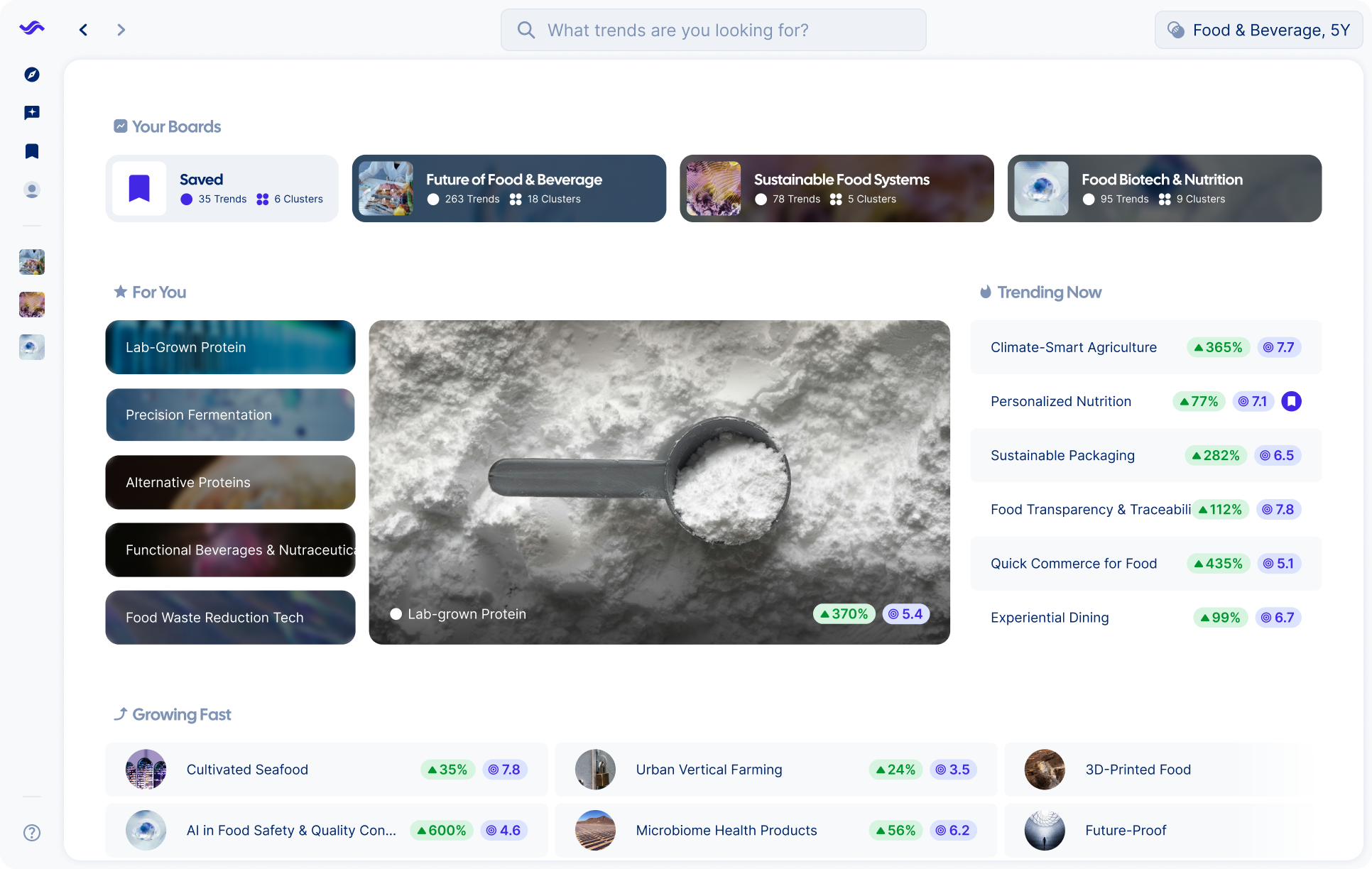
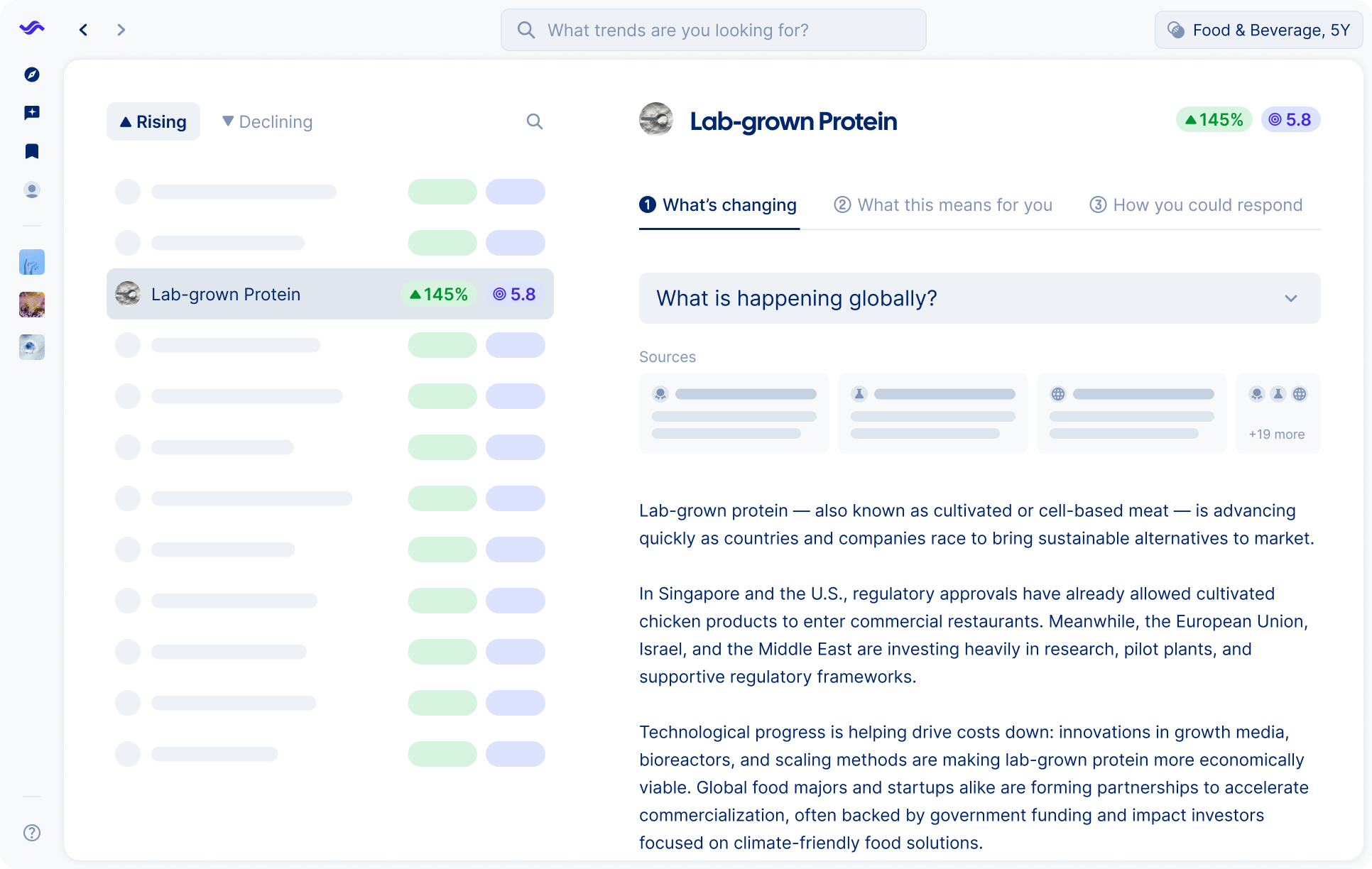
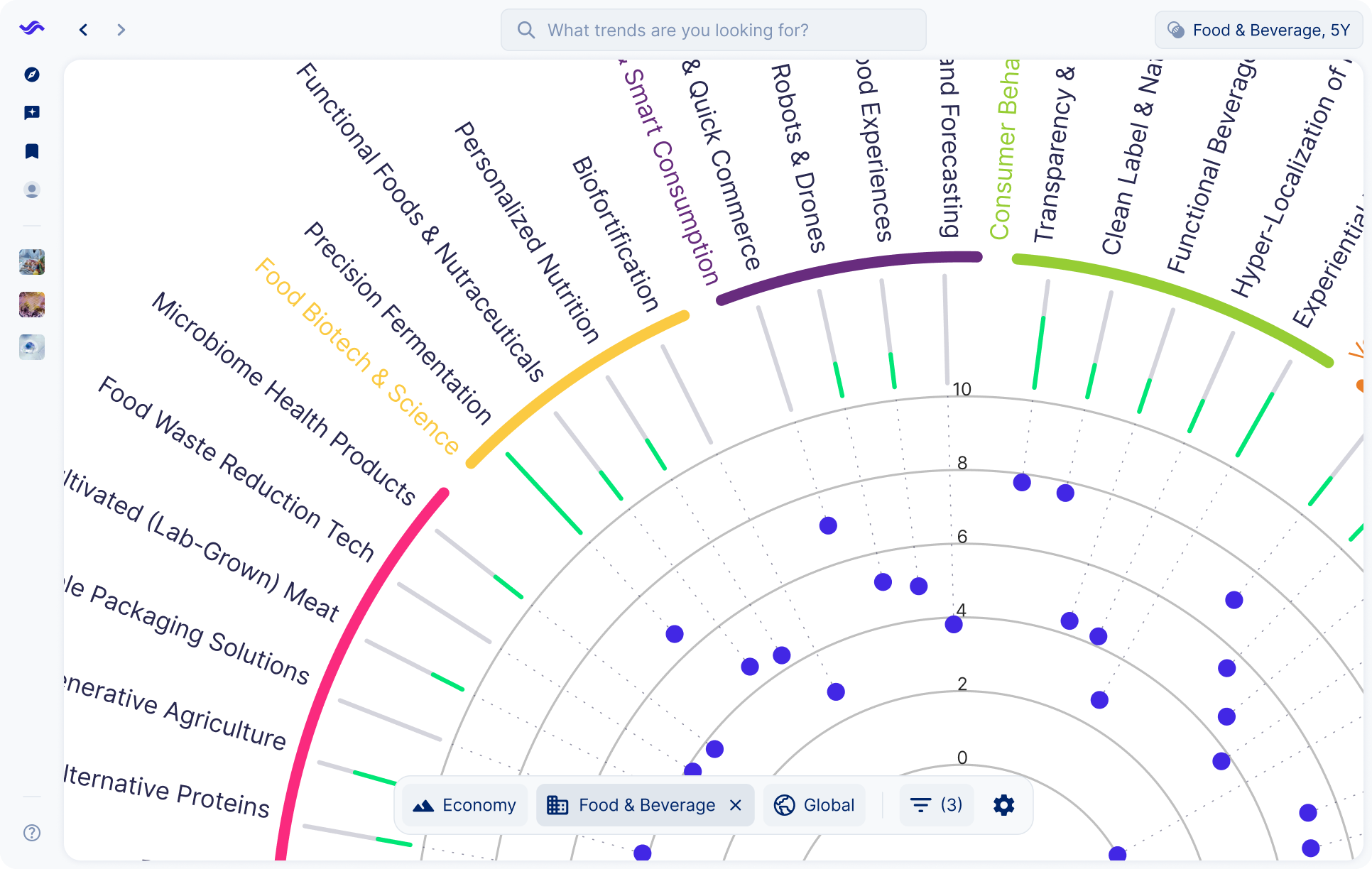
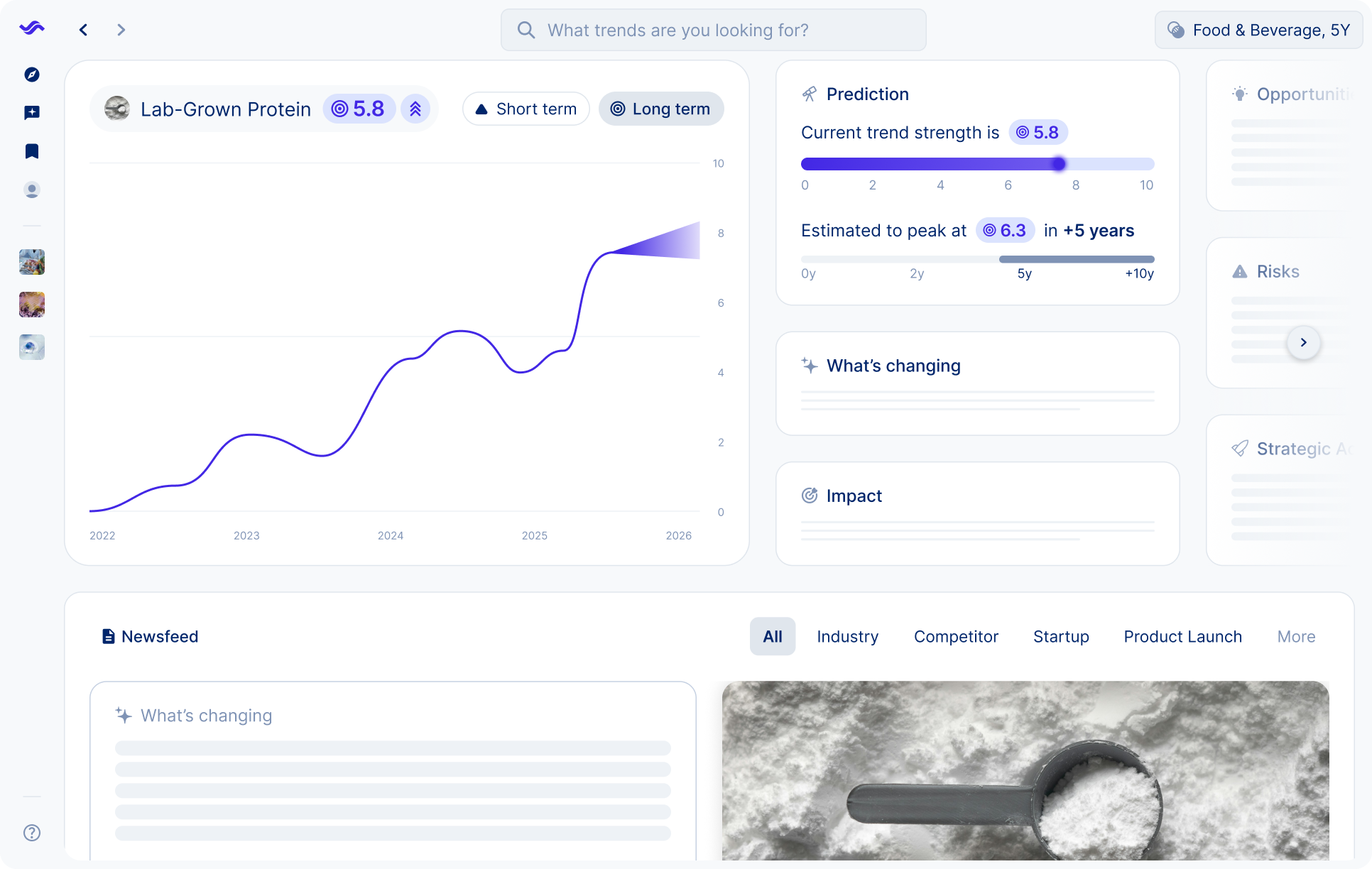

Spot emerging shifts early
See your strategic landscape clearly
Make sense of complex change
Track trends in real time
Key benefits
Strategists trust Trendtracker to turn data overload into instant, actionable insights.
Trends in the industry


Food systems worldwide are under growing pressure from climate change. Droughts, floods and rising temperatures are disrupting supply stability. In response, governments, researchers and businesses are investing in climate-resilient crops, precision farming techniques and AI-driven monitoring systems. From the adoption of millet and quinoa to genome-edited varieties, the focus is on safeguarding food production while reducing environmental impact.
For the food and beverage sector, climate resilience is becoming a core requirement. Supply chains need to adapt by integrating climate-smart crops and sustainable practices to ensure long-term stability. Consumers are demanding products that are both sustainable and health oriented, while investors and regulators are increasing their expectations for transparency on environmental impact. Companies that do not respond to these shifts risk losing market trust, facing stricter regulations and experiencing operational disruptions.
Companies can act by investing in climate-resilient crops and advanced food technologies that strengthen production efficiency and secure yields despite climate variability. Collaboration with agri-tech innovators makes it possible to introduce AI monitoring and precision farming methods that improve resource use. Educating consumers on resilient food options helps strengthen demand and loyalty. At the same time, expanding into regions most affected by climate change opens up new growth opportunities while supporting long-term food security.
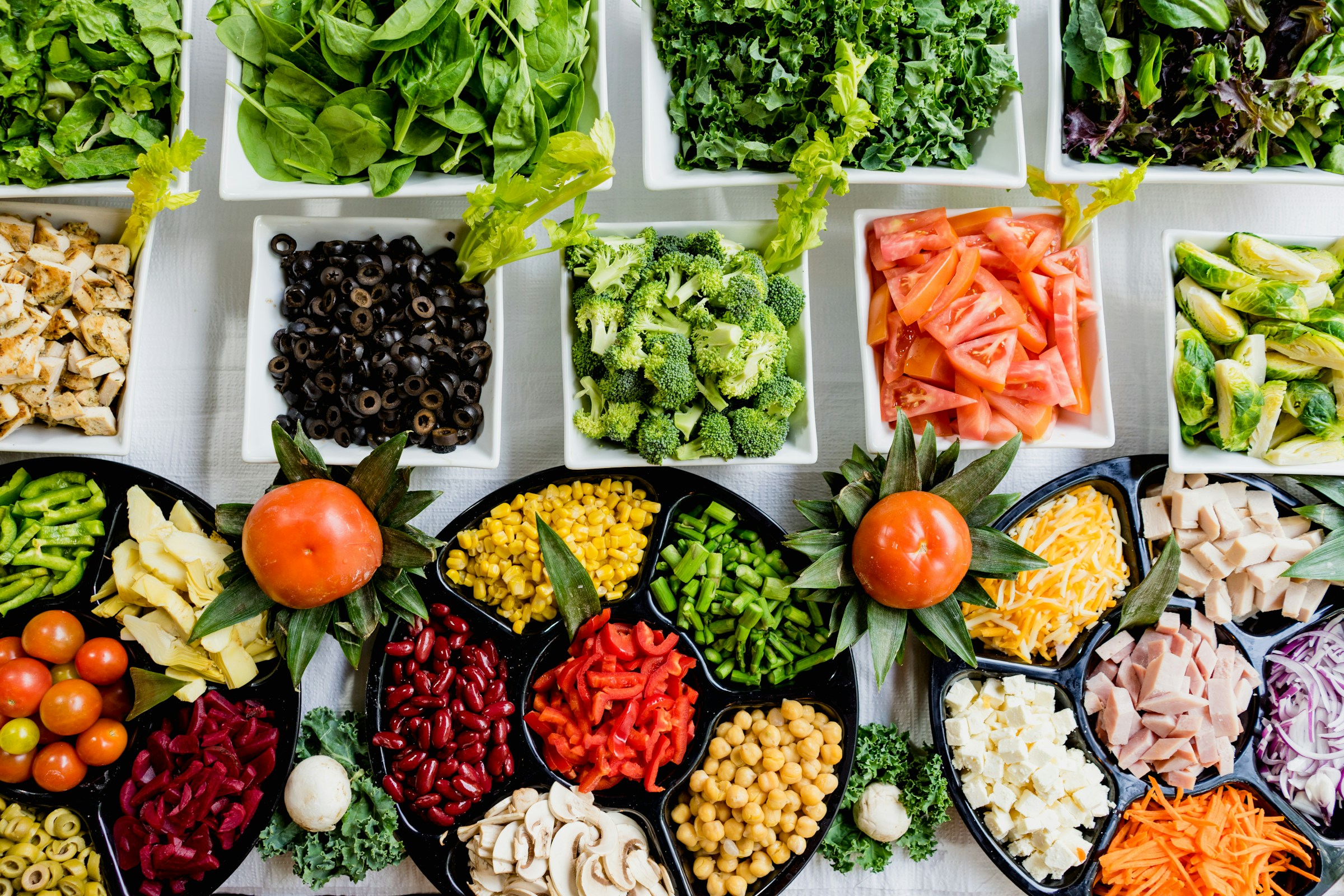

The functional nutrition market is growing rapidly as consumers look for food and beverages that deliver more than basic nutrition. Products with added benefits, such as prebiotics, bioactive ingredients and gut health boosters, are driving demand. Large brands are expanding into functional beverages, while innovation is spreading across categories from snacks to supplements.
Health and wellness are becoming decisive factors in consumer choice. This shift pushes manufacturers to reformulate products, suppliers to provide high quality functional ingredients and retailers to expand their assortments. Investors increasingly view companies in this space as future growth leaders, while regulators are tightening standards to ensure both health claims and product integrity are reliable.
Companies should invest in R&D for functional ingredients, build partnerships with specialized suppliers and use consumer education to strengthen trust and brand loyalty. Expanding into new product categories and geographic markets can capture emerging demand, while digital channels create opportunities for direct engagement with health conscious consumers.
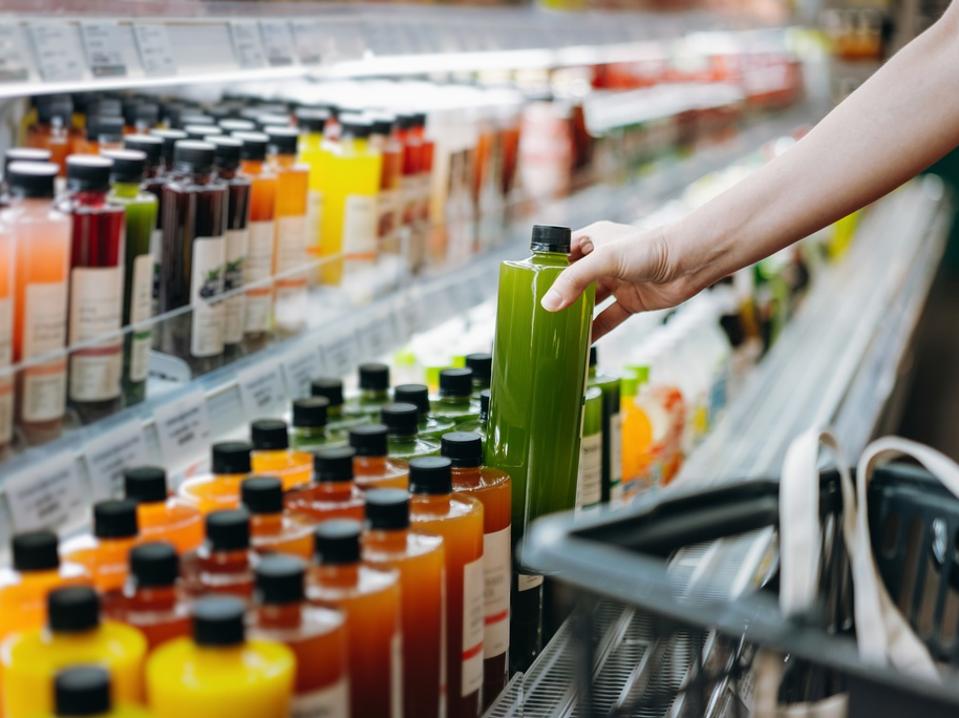

The functional beverage market is expanding quickly as consumers seek drinks that deliver more than refreshment. From prebiotic sodas and hydration boosters to energy drinks with added protein or cognitive enhancers, companies are blending health benefits with traditional beverage formats. Regulatory scrutiny is also shaping the sector, with new rules on caffeine and health claims influencing product innovation and market strategies.
For food and beverage players, functional drinks represent one of the fastest-growing and most profitable segments. They allow brands to align with health and wellness trends while appealing to consumers willing to pay premium prices for added value. At the same time, retailers must adapt to shifting product assortments, suppliers face pressure to deliver high quality functional ingredients, and companies are expected to meet evolving standards on labeling and claims.
Companies should expand product portfolios with beverages that combine taste and science, invest in partnerships with ingredient specialists to secure supply, and strengthen distribution through direct to consumer and digital channels. Communicating clear health benefits builds trust with consumers, while sustainable packaging and responsible marketing can differentiate brands in a highly competitive market.
Stop piecing together scattered reports. See how Trendtracker’s AI turns information overload into instant, actionable clarity for energy strategists.
The insurance industry in 2025 faces rising pressure from climate risk, demographic shifts, and new regulation. Natural catastrophes and secondary perils are driving higher losses, while the protection gap is widening as affordability challenges leave more households and businesses underinsured. At the same time, frameworks such as the EU CSRD sustainability reporting rules and supervisory stress testing are reshaping how insurers manage capital, resilience, and disclosures.
On the digital front, artificial intelligence (AI) is moving from pilots to scale under stricter rules like the EU AI Act, while cyber insurance struggles with systemic risk despite stabilizing prices. Distribution is shifting into ecosystems and embedded insurance, where coverage is offered at the point of need.
Insurers that adapt to these insurance industry trends will move beyond risk transfer toward delivering resilience, transparency, and trust — turning today’s pressures into tomorrow’s competitive edge.
Extreme weather, resource scarcity, and new consumer expectations are reshaping how food is produced. The sector is moving from efficiency-focused operations toward resilience, circularity, and low-carbon innovation.
Today’s landscape
Food producers are under increasing strain from climate disruptions, such as droughts, floods, and shifting growing zones. Supply chains are being forced to adapt, with resilience now seen as a strategic priority rather than an environmental add-on.
The road ahead
Companies will need to invest in climate-resilient crops, localized sourcing, and regenerative practices. These shifts will redefine competitiveness as governments tighten sustainability standards and global buyers prioritize low-risk suppliers.
PESTLE: Environmental (Env), Political/Legal (P/L), Economic (Econ)
Horizon: Mid- to long-term (5–15y)
Strategic action: Build partnerships with suppliers and governments to enhance regional food security and reduce climate exposure across value chains.
Today’s landscape
Consumers are increasingly linking food to health outcomes. Demand is rising for products that address immunity, gut health, and mental wellbeing—particularly among aging and post-pandemic populations.
The road ahead
Reinsurers warn that 2025 carries a non-trivial chance of a $300B loss year. As capital tightens and volatility persists, pricing and capacity will continue Food companies are blurring lines with healthcare, developing functional ingredients and personalized nutrition solutions. Those able to integrate scientific validation and transparent labeling will build stronger brand trust.
PESTLE: Social (S), Technological (Tech), Economic (Econ)
Horizon: Near- to mid-term (0–5y)
Strategic action: Invest in R&D collaborations with biotech and nutrition startups, and use data insights to personalize health-oriented offerings.
Today’s landscape
Costs are expected to fall as bioreactor technology matures and regulation advances. Early adopters will secure market share in sustainable protein while building diversified portfolios that include both plant-based and cultivated options.
The road ahead
Momentum is building for parametric products to integrate with adaptation finance and resilience services. Expect broader uptake in public-sector risk pools, supply-chain protection, and mid-market portfolios, where affordability and speed are critical. Over time, parametric insurance will shift from being a complement to becoming a core element of resilience strategy.
PESTLE: Technological (Tech), Environmental (Env), Economic (Econ)
Horizon: Mid-term (5–10y)
Strategic action: Strengthen partnerships across tech, agriculture, and retail to scale production and navigate emerging regulatory frameworks.

Food systems worldwide are under growing pressure from climate change. Droughts, floods and rising temperatures are disrupting supply stability. In response, governments, researchers and businesses are investing in climate-resilient crops, precision farming techniques and AI-driven monitoring systems. From the adoption of millet and quinoa to genome-edited varieties, the focus is on safeguarding food production while reducing environmental impact.
The functional nutrition market is growing rapidly as consumers look for food and beverages that deliver more than basic nutrition. Products with added benefits, such as prebiotics, bioactive ingredients and gut health boosters, are driving demand. Large brands are expanding into functional beverages, while innovation is spreading across categories from snacks to supplements.
Companies can act by investing in climate-resilient crops and advanced food technologies that strengthen production efficiency and secure yields despite climate variability. Collaboration with agri-tech innovators makes it possible to introduce AI monitoring and precision farming methods that improve resource use. Educating consumers on resilient food options helps strengthen demand and loyalty. At the same time, expanding into regions most affected by climate change opens up new growth opportunities while supporting long-term food security.
The functional nutrition market is growing rapidly as consumers look for food and beverages that deliver more than basic nutrition. Products with added benefits, such as prebiotics, bioactive ingredients and gut health boosters, are driving demand. Large brands are expanding into functional beverages, while innovation is spreading across categories from snacks to supplements.
Health and wellness are becoming decisive factors in consumer choice. This shift pushes manufacturers to reformulate products, suppliers to provide high quality functional ingredients and retailers to expand their assortments. Investors increasingly view companies in this space as future growth leaders, while regulators are tightening standards to ensure both health claims and product integrity are reliable.
Companies should invest in R&D for functional ingredients, build partnerships with specialized suppliers and use consumer education to strengthen trust and brand loyalty. Expanding into new product categories and geographic markets can capture emerging demand, while digital channels create opportunities for direct engagement with health conscious consumers.
Lab-grown protein is moving from experimental labs to market-ready solutions, powered by technological advances and shifting consumer preferences toward sustainability and ethical food choices. Countries like Singapore are leading in regulatory approvals, while biotech firms and food companies are forming partnerships to accelerate production. Although cultural perceptions and regulatory hurdles still limit adoption in some regions, the trajectory points to lab-grown protein becoming a viable alternative to traditional meat.
For the food and beverage sector, cultivated proteins open the door to a new category that could redefine supply chains and product portfolios. By offering an alternative to resource-intensive livestock production, companies can reduce exposure to commodity price fluctuations and align with sustainability commitments. At the same time, acceptance varies widely across markets, requiring careful positioning, education and regulatory engagement.
Food companies should explore partnerships with biotech innovators to scale production, invest in local facilities to strengthen regulatory compliance and supply security, and integrate cultivated proteins into sustainable product lines. Educating consumers about health and environmental benefits will be essential for building trust and loyalty. Those who succeed will gain an edge in shaping the next era of protein innovation.
Volatility in energy prices, logistics disruptions, and geopolitical tensions are redefining global food flows. Transparency, traceability, and risk management are now central to maintaining food system stability.
Today’s landscape
Scandals around food fraud, contamination, and carbon labeling are driving the need for verifiable transparency. AI and blockchain are emerging as essential tools for tracking origin, safety, and sustainability metrics across complex supply networks.
The road ahead
Companies that digitize traceability will improve crisis response and compliance while gaining a competitive advantage with data-driven brand credibility.
PESTLE: Technological (Tech), Political/Legal (P/L), Social (S)
Horizon: Near-term (0–5y)
Strategic action: Deploy digital ledger systems and AI-enabled monitoring to verify sourcing claims and anticipate risks before disruptions occur.
Cyber premiums are softening as controls improve, yet catastrophic systemic events remain largely uninsurable.
Today’s landscape
Conflicts, export bans, and trade policy shifts are destabilizing global food flows. Import-dependent regions face rising prices and shortages, forcing companies to rethink sourcing and logistics.
The road ahead
Food multinationals will localize production, diversify supplier bases, and explore alternative shipping routes to secure continuity. Those that anticipate geopolitical risks will capture opportunities in regional self-sufficiency initiatives.
PESTLE: Political/Legal (P/L), Economic (Econ), Environmental (Env)
Horizon: Mid-term (5–10y)
Strategic action: Invest in scenario modeling and risk dashboards to evaluate geopolitical exposure and ensure resilient sourcing strategies.
Today’s landscape
Labor shortages and rising costs are accelerating automation in food processing, packaging, and logistics. Robots and AI-driven quality control are improving consistency and safety standards.
The road ahead
Automation will expand into adaptive manufacturing, enabling real-time response to demand and reducing energy waste. This will reshape workforce structures and open opportunities for high-skilled jobs in operations and analytics.
PESTLE: Technological (Tech), Economic (Econ), Social (S)
Horizon: Near-term (0–3y)
Strategic action: Combine automation with workforce reskilling programs to boost operational agility and sustainability in production lines.

Lab-grown protein is moving from experimental labs to market-ready solutions, powered by technological advances and shifting consumer preferences toward sustainability and ethical food choices. Countries like Singapore are leading in regulatory approvals, while biotech firms and food companies are forming partnerships to accelerate production. Although cultural perceptions and regulatory hurdles still limit adoption in some regions, the trajectory points to lab-grown protein becoming a viable alternative to traditional meat.
The modern food consumer is more informed, more demanding, and more connected than ever. They expect transparency, personalization, and purpose from the brands they buy. Food and beverage companies are rethinking how they communicate value, build trust, and innovate for evolving lifestyles.
Aging populations are driving insurers to combine protection, savings, and services into holistic health-wealth models.
Today’s landscape
The Geneva Association and other industry bodies highlight a shift toward integrated strategies for longevity. Insurers are moving beyond the traditional divide between life and health to create bundled approaches that address longer lifespans, retirement adequacy, and wellness.
The road ahead
Hybrid products that merge wellness and income protection, decumulation advice, and service-led engagement are set to expand. Strong data governance will be essential as personalization deepens, with health outcomes and prevention becoming key differentiators.
PESTLE: Social (S), Economic (Econ), Technological (T)
Horizon: Mid-term (2–5y)
Strategic action: Explore — prototype longevity bundles for pre- and post-retirees with measurable health outcomes.
Supervisory stress testing is expanding as a regulatory force, pushing insurers to prove resilience under harsher macro, climate, and geopolitical scenarios.
Today’s landscape
EIOPA’s 2024 stress test assessed large EU groups, flagging gaps in scenario modeling and data lineage. National supervisors are echoing these findings, broadening expectations beyond solvency into liquidity, climate transition, and geopolitical shocks. While firms treat stress tests as compliance, supervisors are increasingly insisting that results feed directly into risk and capital planning.
The road ahead
Stress testing will not create new products or revenue streams, but it will shape how insurers deploy capital, buy reinsurance, and justify resilience to regulators and investors. Boards will need to treat supervisory scenarios as part of strategic planning, not just reporting. Those that use them to sharpen resilience and communicate credibility may secure an edge in stakeholder trust.
PESTLE: Political/Legal (P/L), Economic (Econ)
Horizon: Near-term (0–2y)
Strategic action: Incorporate — embed supervisory stress-test scenarios into capital allocation and reinsurance strategy, using results to inform board-level resilience narratives.
The EU’s new reporting regime is embedding sustainability data into insurer disclosures — and gradually into underwriting and investment decisions.
Today’s landscape
Insurers across the EU published their first CSRD reports in 2025, including transition plans and financed emissions. While progress is visible, insured-emissions data remains the toughest gap. Ongoing adjustments to the CSRD may reduce reporting requirements for SMEs, which could limit data availability for risk assessments and underwriting.
The road ahead
Disclosures will move beyond compliance. Supervisors and investors will expect insurers to connect CSRD data to how they select risks, price policies, and manage investments. Templates and thresholds will evolve, but the direction is clear: sustainability data is becoming a factor in underwriting legitimacy and capital allocation.
PESTLE: Legal (L), Environmental (E), Economic (Econ)
Horizon: Near-term (0–2y)
Strategic action: Recognize — define how CSRD metrics such as transition plans and emissions data shape both underwriting criteria and investment stewardship.
